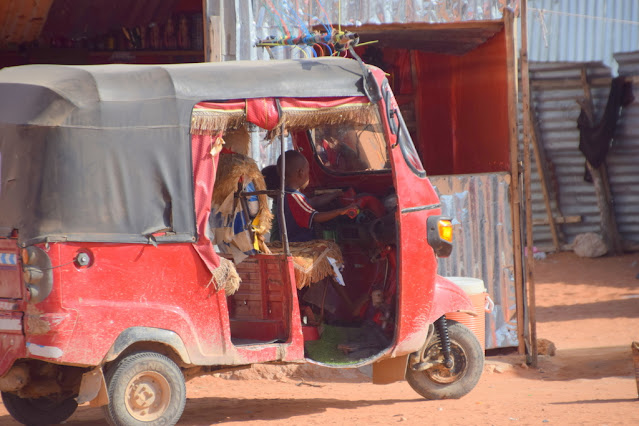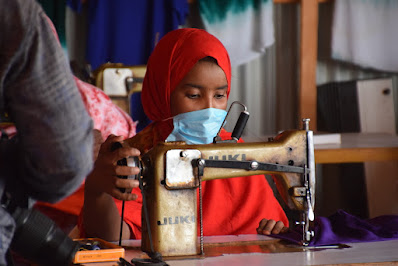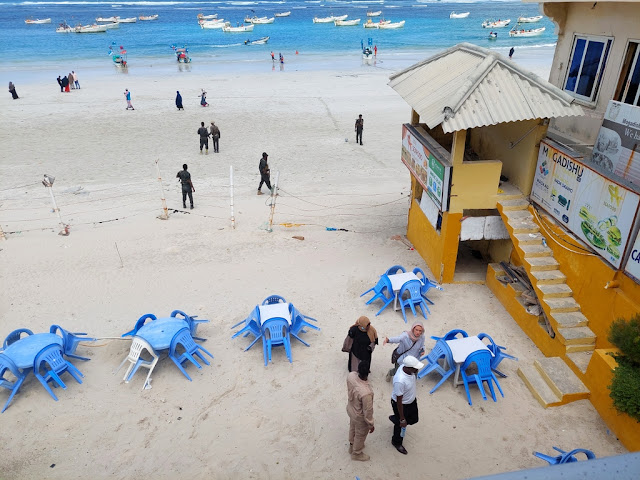There’s no question that I have been able to catch up on some lost time in Somalia. It’s been something that I’ve been needing to do. Wanting to do. I always have mixed feelings about it, as I’ve mentioned before. I love connecting with staff and seeing the work on the ground. We’ve been able to accomplish so much in many of these communities. But it’s brutal to see the conditions so many others are living in and hearing their stories. It’s a harsh wake-up call that the world is simply not fair. I also don't like spending so much time away from my family.
* * *
On this occasion I would be traveling with a couple of colleagues from NY. I intentionally avoid using most people’s names, limit how much I show people in photos, just in case they’re not keen on appearing in someone’s blog. They may show up in a photo here and there but I try to keep it pretty anonymous.
Our trip would start in Nairobi where we would catch the usual 4am taxi to the airport. Travel went without a hitch and by about 9am we were navigating the streets of Mogadishu in our armored vehicle with our armed escort. Neither of the visitors had had this kind of security treatment. One of them hadn’t ever been to a setting like this at all. I think it came as a bit of a shock. Admittedly, it’s a bit strange and intimidating in the beginning for even the most seasoned traveler.
Part of it is simply the lack of familiarity. It’s difficult to be plopped down in any setting not knowing what the risks are. The longer you’re there, the more you begin to understand what you should be afraid of and what is probably an insignificant risk. A lot of it is down to perception. In the US, people have developed fears due to mass shootings that have taken place. Many of these fears are irrational given the statistical unlikelihood of something happening in your school, shopping mall, etc. but your perception of the danger can drive how much of your mental energy is spent on fear and precautionary actions.
Having done what I do for a long time, I find that some precautionary actions are simply built into me now. Some of it comes from lots of training that I’ve had. Most of the time I don’t even think about. How do I hold a bag when I walk down the street? I scan people/motorcyclists on the street to anticipate potential threat of theft. Where do I position myself in a restaurant (ex. never with my back to the door)? I always scan a room to look for alternative exits. Even when it’s unnecessary, I habitually back a vehicle into parking spaces (ready position). Most of these habits will probably be with me until the day I die.
In Nairobi, these precautions are not unreasonable. A few weeks ago when I was jogging, soon after I passed a side street, a motorcycle with two guys on it came around the corner and the guy sitting on the back of the bike took a swipe at my cell phone (in my pocket attached to earbuds). Apparently one tactic these guys use is to sit on a side street and watch passers by on a busier street. When they see a likely target, they zoom out, come from behind and rob them. In my case, the guy missed. Interestingly, he was not wearing a mask (something that would not draw attention these days and serve to hide his identity). After missing his target, the passenger looked back at me, gave me a half smile, shrugged his shoulders and they disappeared down the road.
* * *
Our first stop in Mogadishu was a hospital that we support wedged tightly in a neighborhood not far from our office. The dirt path (not really a street) to access it is barely wider than a vehicle. Our staff, and people accessing services, generally arrive on foot or occasionally by motorcycle. It’s a good clinic though, albeit a bit cramped. It’s a corrugated metal structure, like those around it, with about twelve rooms. The drought is causing an increase in activity, particularly with regards to malnutrition cases. There must be thousands of these facilities around the world and they are so critical for the communities they serve.
 |
| colorful waiting area |
Next we went to the northern side of the city. If someone follows this blog, the place will look familiar. There is no place I’ve visited more frequently. It’s a nice facility, clean, and it involves a drive across Mogadishu to get there. I feel like it’s important for visitors to experience the rather messy drive across the city to get a feel for our context.
 | |||||
| scars from war |
After the visit, we went to lunch. Not just any lunch. We thought we’d treat our guests to lobster at a beach restaurant. It’s not something most people get a chance to do. I’ve done it several times and it’s not always an option given the security situation. But this time we felt confident that we could pull it off. It’s always such a treat to walk on the beach, sit for a bit and have some lunch, enjoy the view, feel the breeze, etc. Given how much one feels closed in with all the security and lack of ability to move around autonomously, getting out like this is wonderful. It’s also a glimpse of what an amazing place Somalia is, or at least could be.
 |
| lobster on the beach - future tourist destination? |
* * *
The next day we were off to the interior of the country. Galkacyo is about midway between the north and the south, near the border with Ethiopia. I had just been there with a colleague a week and a half prior (see blog before last). It’s relatively accessible and a big portion of our drought response. It’s rather vast, though, and involves lots of driving on bumpy roads.
 |
| gotta love camels |
The visit unfolded in similar fashion to the previous trip so I won’t repeat myself. Long drives. Sad/tragic stories. Inspiring stories. Camels. More driving. More stories. Camels. Repeat.
 |
| so many cute kids |
Though I saw a few things and people that I’d seen on the
previous trip, we did take some roads I hadn’t been on before. They’re not
always accessible given the evolving security situation but on this occasion
there weren’t any issues.
 |
| kid pretending to drive - I remember doing the same though not in a tuk-tuk |
 |
| solar-powered water pump providing water during drought |
It’s also a good opportunity to reflect again on what we’re doing and what we might be able to do to expedite the response. Improve the coverage. Etc. Listening to the local elders as well as those who have been displaced from their homes provide a wealth of information to my team as we adapt our interventions to an evolving situation. It’s impossible to respond to all the needs, obviously, and there are some hard choices to make – a triage of sorts – to focus on saving lives. It means not responding to some needs in the interest of more critical needs as we’re moving from severe drought to potential famine.
 |
| safe space for women and girls - skills training |
 |
| tough living conditions for those displaced by drought |
 |
| 9 vehicle convoy - not very discreet while traveling through the country |
* * *
After two days, we made our way back to Mogadishu. On the return there were no activity visits. There would only be time for a staff meeting, which was focused on our guests. I wasn’t able to attend due to a Queen’s Day event at the UK embassy, within the fortified “green zone”. I don’t generally spend much time there but it’s important for me to connect with many of the people that do. As such, I made it a priority to attend and pay my respects to the 96-year-old sovereign. We’re not sure how many more Queen’s Days there will be before they change to King’s Day.
 |
| gorgeous view from a compound within the fortified airport |
It's the first time they’ve had this event since the pandemic. I attended in the years prior. You’re basically in a fortified compound which sits in the larger fortified compound. You’re surrounded by unattractive Hesco walls. (If you’re not familiar with the term Hesco, it is one of those terms that is a company name gradually becoming just a common name for lined wire 4 ft. cubes filled with sand that, when stacked, form a security barrier. They’re often the fortifier of choice given that they absorb blasts well. Unlike cement walls which fracture into small pieces (i.e. projectiles) consequently amplifying the impact of a blast.) Sharpshooters with shades stand atop the container buildings as people in suits mingle on the artificial turf below sipping juice. Alcohol is illegal in Somalia but the “green zone”, which is a fortified sea of UN and international organizations, has different rules for just about everything. Just about anything goes. However, at events that include Somalis such as this one, no booze.


